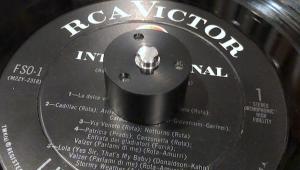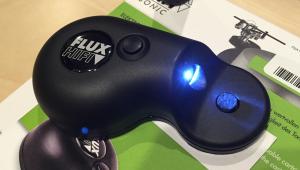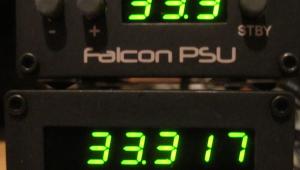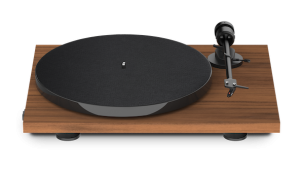I replaced a Q-Up with a Little Fwend on my VPI Classic Signature. It doesn't perform it's job any better than the vastly cheaper Q-Up, but it does that job in a far more refined manner and doesn't look like a cheap add-on when it's in place. The Q-Up's loud 'clack' sound when it engaged always made me cringe a bit, whereas the Little Fwend is completely silent in operation. No regrets.
Say Hello to My "Little Fwend" Automatic Tone Arm Lifter

The only time it can actually be bad for your cartridge is if you are playing an older, '50s era LP with a "violent" lead out groove designed to trip a clunky old record changer. Those records can give your cartridge a nasty workout that can include, in rare instances, time spent on the paper label and then back into the modulated groove area, though if you've ever experienced that, it's usually as effective a wake-up call as an alarm clock.
In a review of Sota's Moonbeam turntable, we covered the inexpensive QUP automatic arm lifter. It's an undamped, lightweight $50 plastic device that works reasonably well and is certainly appropriate to use in a moderately priced rig but if you've got thousands invested in a cartridge you might consider the $249 "Little Fwend" made in Scandinavia.
This is beautifully machined item available in three sizes (two are in the distribution chain, one as special order directly from Little Fwend. Despite the available variety there's no guarantee one will fit on your turntable, mostly because of distance between platter and arm base. For that reason Little Fwend offers an online list of known compatible turntables.
The lift cylinder is smooth-operating and well-damped, which results in a gentle rise, free of bouncing or "violent upheavals" as the arm rises, regarding of its mass or tracking force. Little Fwend provides excellent set-up instructions and includes both magnetic and adhesive ways to fix the base to your turntable.
The Little Fwend is packaged and presented as thoughtfully as it is manufactured. In the embedded video you will see a situation where it just barely fits between the under review EAT B Sharp turntable's platter and arm base. You'll also see that the rubber topped lifter contacts a screw instead of the arm itself. Not a problem but the point is, compatibility should be considered before you purchase one. Another issue in this particular install is that the "antenna" that the arm contacts is very close to the platter, which makes putting the record on the platter a bit tricky.
In this situation adding a Little Fwend may not be worth the inconvenience, but that of course is your choice. Where the Little Fwend is more compatible, it's a well worthwhile accessory especially if you are prone to dozing off before a record ends! As you'll see in the video, the Little Fwend is a smooth operator. If you own a premium rig, you'll appreciate the machine and plating quality too.
In America Little Fwend is available from Music Direct and perhaps from others as well. It's an easy product to recommend for its thoughtful packaging, excellent instructions, high quality construction and especially for how gently and reliably it does its job.
- Log in or register to post comments


I also replaced a Q-UP with one of these, on my VPI Prime. It has worked seamlessly for over a year now.
Note that VPI has now released their own version, called the Tru-Lift. I haven't tried it, but it is well reviewed on the VPI forum. People may want to consider this one too.
https://www.musicdirect.com/accessories/VPI-Tru-Lift-Tonearm-Lifter

I have this on my VPI Classic. I like the smooth lift and high quality looks. It’s magnetic bottom sticks right to the Classic plinth without having to use the sticky backing.

This looks like a nifty device but I wondered "how is it powered?"
I couldn't find any mention of this in the review, nor on the website.
Then I looked at the video again and realized I must have been fooled by a sound on the video. Just when the fwend lifts up the tonearm the first time a motor sound begins on the video, so I presumed that was the sound of the fwend motor lifting. I guess it was just a coincidence caught on the video and the fwend isn't powered?



So I bought a Little Fwend for my original VPI Prime and much to my dismay, it needed to be stuck on to the plinth with a peel and stick adhesive. I recently upgraded my Prime to the Rosewood Prime Signature edition and there was no way I was sticking anything to the piece of art that is the rosewood plinth. But after a night of listening to LP's and drinking perhaps one too many glasses of wine, I woke up the following morning to the sounds of my SoundSmith Paua cartridge grinding away at the end of MOFI's Bill Evans Ultra-Disc reissue (absolutely stunning, BTW). Bummer! Until now:
http://www.elusivedisc.com/VPI-Tru-Lift-Automatic-Tonearm-Lift-For-VPI-P...
Voila, a tone arm lifter made by Integrity for VPI that is sufficiently weighted to hold itself in place, no adhesive necessary. Works beautifully, and your plinth will thank you for it!

I checked the price of this gadget and I think I will continue to lift the tone arm manually.

I have owned a Tru Lift for years. The people who make it are sincere, friendly, and helpful but I have to say that it is greatly inferior to the Little Fwend. The Tru Lift is fussy and requires lots of fine tuning to the tension on the antenna. Too tight and it doesn't trigger. Too loose and it might pop up in the middle of the record. It is also difficult to position. You have to use Blu Tak on the base and that makes moving it around on the plinth troublesome. Finally I grew so frustrated and annoyed that I ordered a Little Fwend despite the fact that it was as costly as the Tru Lift. All problems disappear with the Little Fwend. It works reliably and is much easier to set up. The magnetic base is a godsend and so is the arm with the rubber insert. It's definitely the way to go.

As the reviewer pointed out, there are different methods to attach the Fwend to the turntable. The included super strong neodymium magnetic discs have adhesive on one side. Two disc sizes came with the Fwend Music Direct sent me: two smaller ones that are the same size as the base of the Fwend, and a slightly larger one. There was also a non magnetic adhesive vinyl pad that could be used sans magnet. I mounted one of the small magnets to my TT base and was able to remove it for repositioning with some effort. It continues to hold tight to the aluminum base of my Project TT and it left no marks on the finish when I repositioned it.
The larger magnetic mounting disc could be used if you needed to change the position of the Fwend from time to time. Why would you need to do this? I found that some newer LPs are cut slightly larger than 12", so the antenna scrapes against the edge of the vinyl in its normal position. The larger magnetic mounting disc would allow you to move the Fwend in any direction a mm or two while still maintaining full adhesion. Wiggle room, if you will. The downside? Aesthetics. The larger magnetic disc looks less precise.
On my Project Classic, the space available for the Fwend is pretty minimal. It works great on most of my records, but there are exceptions that require slight repositioning or removal of the Fwend altogether (you can easily rotate it out of the path of the tonearm). Since the Little Fwend is held in place by a powerful neodymium magnet, it's very stable, but it can be repositioned or removed and replaced over and over again without losing adhesion.
The downsides other than the exceptions outlined above are as follows:
1. It's easy to forget to arm the Fwend. About 2-4 minutes into the music, the stylus gets stuck on the same groove because it's encountering the tonearm platform in its 'up' position. It's not too violent sounding and I doubt whether it does much damage, but I've posted a sticky note to remind me to "arm the Fwend." On some decks, it may be possible to position the Fwend so that the record will not begin to play until the platform is in its 'down' position.
2. Depending on your turntable, if you are playing a long album (>20 minutes per side), the tonearm could lift before the end of the last song if you don't have the Fwend positioned precisely or have slight clearance issues like my Project Classic. If you're really into the music, it's like the vinyl version of coitus interruptus. Buzz kill. Side Two of Hasten Down the Wind will prompt this minor disaster on my turntable. No harm to anything except it spoils the crescendo at the end of "Someone to Lay Down Beside Me."
3. I was so anxious to hear my brand new vinyl version of Loveless that I slapped it down with the antenna trapped between the platter mat and the vinyl. I started to crank down the record clamp before I noticed it was part of a vinyl/leather sandwich. Thinking I had surely mutilated the antenna beyond recognition and scratched my beloved LP, I lifted the Kevin Shields masterpiece from the mat. The antenna sprung back to its original position no worse for wear and in perfect alignment. I'm not counting on that kind of luck the next time that happens. No damage to My Bloody Valentine either (some of you will be disappointed with the outcome of the latter).
4. Do not attempt to arm the Fwend while the record is playing. You're just asking for a broken cantilever. Lift the tonearm from the record first if you forget to arm the system before you drop the needle.
OK--again, sorry I got carried away, but $250 for this little device is a significant investment, and I thought that my experiences might help. Yes...I'd buy it again. The design is elegant and you will eventually make it a part of your routine, just like activating your turn signals on your car when changing lanes. Maybe that's a bad simile.

















































